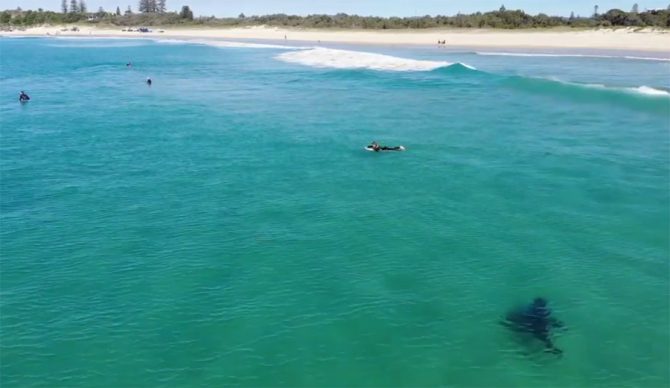
A shark and a surfer in New South Wales. Photo: Screenshot
A shark encounter is every surfer’s worst nightmare, especially during a solo session. And the farther from shore you are, the more helpless you feel. I had this fear activated many times while surfing, sometimes alone, on Reunion Island last year – an island renowned for its concentration of attacks. This dormant fear was re-aggravated as I was doing my Instagram scroll last week. I came across a post of Tyler O’Reilly, a Central California surfer, who detailed a recent shark encounter during a solo surf at a beachbreak near Morro Bay. He experienced a cut leash, a wetsuit tear, and lots of shark slime, but luckily walked away unscathed.
As deep as the fear of a shark attack runs among surfers, being involved in an encounter is extremely rare. The chances vary depending on where you live and what water activity you’re doing. Let’s take a look at where in the world, and what water sports, will increase those minuscule chances of having a run in with a shark.
To put it simply, the place that you’re most likely to get bit by a shark is…(drum roll)…Florida. Of the 69 unprovoked bites recorded worldwide in 2023, according to the Florida Museum of Natural History, Florida accounted for 16, or 23 percent. Of those 16 bites, half of them occurred along the 47 miles of coast in just one county – Volusia. However, it’s worth noting that none of those 16 bites in Florida in 2023 proved fatal.
An unprovoked bite is defined as “incidents in which a bite on a live human occurs in the shark’s natural habitat with no human provocation of the shark.” On the other hand, a provoked bite is when humans create the engagement with the shark. Think fishing or diving.
As far as country’s go, the U.S. and its bountiful coastline accounted for more than half, 52 percent, of all unprovoked attacks in 2023. The 36 attacks in U.S. waters were distributed among Florida (16), Hawaii (8), New York (4), North Carolina (3), California (2), South Carolina (2), and New Jersey (1). Four of those 36 bites were fatal.
Of the 10 unprovoked deaths worldwide in 2023, four of them were due to white sharks. The only other sharks which accounted for fatalities were bull and tiger. White sharks can be found in temperate and tropical coastal waters all over the world. They’re known to be abundant on the U.S. East/Gulf Coasts (particularly in the Cape Cod area, which is said to have the highest concentration in the world during the summer/fall migration), the Northeastern Pacific between California and Hawaii, South Africa, and Australia/New Zealand.
According to Gavin Naylor of the University of Florida, the white shark attacks are probably due to growing populations, particularly in areas where seals are the main food source, animals that have an uncanny resemblance to surfers. As more people start surfing and shark populations continue to grow, Naylor thinks these white shark attacks might become “a little bit more commonplace.”
Three of those white shark fatalities occurred in Australia, the second most likely country to experience a shark bite. The country experienced 15 unprovoked bites in 2023, four of which were fatal. The attacks in Australia were spread fairly uniformly around the country. While seven occurred in western Australia, South Australia, Queensland, New South Wales, and Tasmania also registered attacks.
The U.S. and Australia are by far the shark attack leaders of the world, but attacks were also recorded in 12 other countries: New Caledonia, Brazil, Egypt, the Bahamas, Mexico, South Africa, Costa Rica, Colombia, New Zealand, Seychelles, Ecuador (Galapagos), and Turks and Caicos.
So if those are the places where most shark attacks occur, who are the people getting bit? I hate to be the bearer of bad news, but the answer is…surfers.
According to the data, in 2023, 42 percent of all unprovoked attacks were against surfers or boardsport enthusiasts. Thirty-nine percent were swimmers and 13 percent were snorkelers/free divers.
Make what you will of these numbers, but according to the Florida Museum of Natural History, the number of unprovoked attacks is actually proof that humans are not on the menu for sharks.
“(The fact that so few bites occur each year) gives us a pretty strong indication that sharks are trying to avoid us,” said Joe Miguez, a marine ecologist at the University of Florida in Gainesville. “(If sharks thought humans were prey, there might be) thousands of shark attacks each day.”
In order to minimize the chance of having a shark encounter, the Florida Museum of Natural History offers several tips, which include always surfing with a buddy, exercising caution when surfing areas between sand bars or near steep drop offs (typical shark hangouts), avoiding the water during low-light hours when sharks usually feed, not wearing shiny jewelry, and avoiding murky water, among others. For those looking for extra protection, there is technology that can be worn or built into surfboards that is proven to deter sharks, such as Sharkbanz, which “disrupts sharks electroreception.”
Sharks are part of surfers’ everyday reality. But even if you surf every day in Florida’s bite capital of Volusia County, the chances of ever having an encounter or experiencing an attack are miniscule. According to the Florida Museum of Natural History, “You have a better chance of dying from a bee sting, a dog or snake bite, or lightning.”
It’s easy to say don’t be afraid, but for those who’ve been attacked or had loved ones attacked, that’s easier said than done. There’s no logical need to fear sharks, but if surfing in an area known for shark activity, or where an attack recently took place, proceed with caution and heed the advice of local authorities.

